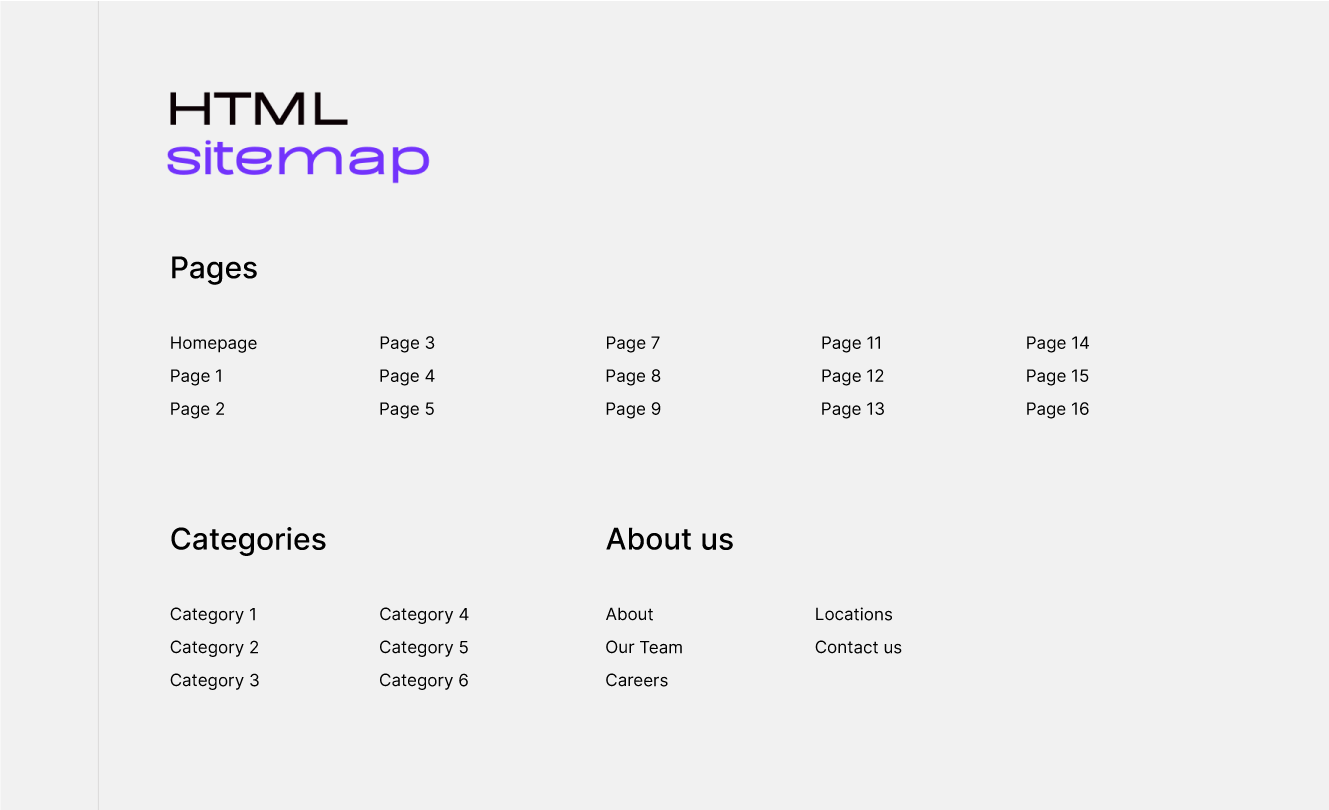
Sitemaps are virtual roadmaps that give Search Engines the guidance needed to understand what pages on a website are important. Today we’re discussing all things sitemaps:
- What are they?
- Why should you have one?
- And what types of sitemaps are there?
Have you got a brand new website and are a little worried about how well it’ll do on Google? You’ve probably put in the time and effort to get the design just right, perfected your keyword optimised copy and wrote a few first pieces of content. Whilst that is a really good start, we do have some bad news for you: All this is of little use if Google can’t quickly find essential pages. Here’s the thing: If your internal link structure isn’t perfect, some pages that you want to rank on Google could be hard to find. Search engines crawl websites using the data available to them, to find and rank content they deem relevant to a search query.
A sitemap is intended to aid web crawlers in their jobs, giving them a little extra input. As opposed to the website hierarchies visible to us users, sitemaps use a structured format that lists the pages in a website, their relative importance, and how often they are updated.

What is a Sitemap?
Simply put, a sitemap is a more condensed version of your website, which contains only the most important pages. Its primary function is to help search engines find, crawl and index content on your website, so it can rank in search results. In doing so, it is a vital part of your SEO practices, helping you to bring traffic to your website.
According to Google, your sitemap tells the search engine “which pages and files you think are important in your site” whilst providing “valuable information about these files: for example, for pages, when the page was last updated, how often the page is changed, and any alternate language versions of a page.” What’s not to love?
Do You Need a Sitemap? Do Sitemaps Help With SEO?
Technically, you do not need a sitemap. Your site can go live without one, and you’ll probably still see some traffic coming in. Let’s say that your website contains only one page, the ‘home page’. In that case, it wouldn’t make sense to submit a sitemap to facilitate the discovery of URLs on your website - after all, there’s just one.Instead, you should focus on linking to your page from other websites and social media. You could also register your domain with the Google Search Console. The latter is a free service provided by Google, which allows website owners to optimise the visibility of their websites. By the way, we do recommend you to make use of this service, even if you choose to submit a sitemap. It’ll make your life a lot easier - and you can use the tool to submit your sitemap to Google.

Why We Recommend You to Submit a Sitemap
It does pay off to have a sitemap. It is certainly worth it from an SEO standpoint. Especially if you have a large site with many pages and rich media content, a sitemap will make it easier to navigate and crawl.
To ensure search engines are crawling the correct, up to date version of your site, your sitemap needs to be constantly updated. It makes new pages easier to find and means updated or newly added content is crawled as soon as possible. You should always upload a sitemap as soon as you create a new website and when updating your current website.
Search Engine Optimisation: Why Sitemaps Are a Necessity
Search Engine Optimisation is the practice of getting your website to rank higher in search engine results. This can be achieved by using a combination of techniques, including keyword optimisation, content marketing, link building and site architecture optimisation. The list goes on and on. What matters, is that it’s the smart combination of several SEO techniques that increases your chances of ranking for certain keywords. Your sitemap may tell search engines what pages on your site you think are the most important, but you still need to offer valuable, search engine optimised content and include relevant keywords in the title and headers of the page, and so on. So whilst having an up-to-date sitemap is particularly helpful and vital for good SEO practices, know that it can’t stand alone.
Different Types of Sitemaps
There are two types of sitemaps: HTML and XML. The former is written for humans and the latter for search engines. To be more specific: HTML sitemaps guide website visitors, helping them to find whatever they are looking for, whilst XML sitemaps ensure that search engine robots can find and index your pages.
- HTML Sitemaps
HTML sitemaps are formatted links, usually found at the bottom of a website and accessible via its header and footer navigation. They help users find important information quickly. This is more to do with user experience than helping Google understand your website.

But, keep in mind that search engines reward easy to use websites, hence the importance for UX design (User Experience). HTML sitemaps also have the added benefit of increasing the internal link count. In many cases, having an HTML sitemap can positively affect your site ranking. HTML sitemaps have their limitations. Integrated into the website via a plug-in (no coding required), the maximum number of linked pages is limited. And there is another size limitation: HTML sitemaps can generally not be larger than 10 megabytes - something to keep in mind when using compressed websites.
- XML Sitemaps
XML sitemaps are convenient, machine-readable lists of the most important pages of a website. As such, they are quite different from HTML sitemaps. The sitemap files, or documents if you prefer, contain URLs to these pages. This helps search engines crawlers to follow and find them, no matter how much mess you or the previous website owner have made.
- XML stands for “Extensible Markup Language,” a simple text-based format that is used to represent and share all sorts of information
An XML sitemap file contains the following information:
- Where on the website is the page is located (its URL): <loc>http://www.sitemaps.com/mypage</loc>
- When was the page last updated: <lastmod>2021-03-03</lastmod>
- How often is the page updated: <changefreq>monthly</changefreq>
- What priority does the page have compared to other pages on the site: <priority>1</priority>
You do have to keep a few things in mind: Whilst simply having a sitemap can speed up indexation, there is no guarantee that it’ll actually get your pages crawled, indexed or ranked. Submitting a sitemap, however, greatly increases your chances.

How to Submit an SEO-Friendly Sitemap
It can take less than 20 minutes to upload a sitemap:
- Create a URL list using software such as Screaming Frog.
- Verify your site ownership with Google - if you haven’t done so already.
- And lastly, submit your sitemap via the Google Search Console.
Key Takeaways
So which sitemap should you use, HTML or XML? The easy answer to this question is both. If you are striving for a well-optimised, user-friendly website that makes it easy for search engines to crawl, index and rank your pages, then put your cards on both types of sitemaps. There are many benefits to both HTML and XML, and a few disadvantages in comparison.
In short, sitemaps might not magically increase traffic or improve your organic search ranking, but when paired with other SEO techniques, they can help improve the user experience and crawlability of your website. And this, in turn, will improve your website ranking over time!If you liked this article check out our post on the Google Search Console, a guide for first-time users, to learn more about search engine optimisation! If you have any questions or concerns, don’t hesitate to contact Anchor Digital’s team of SEO specialists. We’d love to hear from you!





























